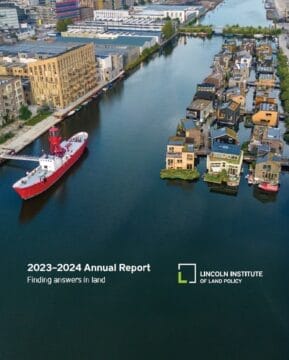About the Lincoln Institute

Who We Are
As a nonprofit private operating foundation whose origins date to 1946, we research and recommend creative approaches to land as a solution to economic, social, and environmental challenges.
Learn More About Our WorkLincoln Institute of Land Policy Mission
The Lincoln Institute of Land Policy seeks to improve quality of life through the effective use, taxation, and stewardship of land. A nonprofit, private operating foundation whose origins date to 1946, the Lincoln Institute researches and recommends creative approaches to land as a solution to economic, social, and environmental challenges. Through education, training, publications, and events, we integrate theory and practice to inform public policy decisions worldwide. We organize our work around three impact areas: land and water; land and fiscal systems; and land and communities. We envision a world where cities and regions prosper and benefit from coordinated land use planning and public finance; where communities thrive from efficient and equitable allocation of limited land resources; and where stewardship of land and water resources ensures a livable future. We work globally, with locations in Cambridge, Massachusetts; Washington, DC; Phoenix, Arizona; and Beijing, China.
Our Vision
We envision a world where prosperous cities and regions provide essential public goods and services through coordinated land use planning and public finance; where efficient and equitable allocation of limited land resources supports thriving communities; and where stewardship of land and water resources ensures a livable future.
Navigating Our Vision

Grow & Produce
Grow the field of land policy research, and produce quality data and findings.
- Produce and collaborate on policy-relevant research and publications
- Cultivate expert networks to share findings and best practices
- Nurture emerging researchers through fellowships and scholarships
- Build and deliver effective curricula based on research and practice
Build Capacity
Build the capacity of decision-makers and practitioners to create and implement effective land policies and practices.
- Focus on decision-makers in local, state, and national levels of government
- Create and disseminate accessible data, tools, and analysis to support effective policy decisions
- Educate and train decision-makers and practitioners
- Facilitate connections among decision-makers, practitioners, and other experts
- Provide technical assistance
- Build communities of practice
Foster Recognition
Foster recognition of land policy as a tool to address important social, economic, and environmental challenges.
- Convene decision-makers and practitioners around key issues
- Expand and inform audiences through strategic communications
- Develop creative approaches to expand knowledge and understanding of the importance of land policy and planning
- Inform active public policy debates

Message from the Chair & President
For generations, the Lincoln Institute has been a well-established force for change and a provider of high-quality education and publications on dozens of topics of global interest.

History of the Lincoln Institute
The Lincoln Institute of Land Policy traces its origins to John C. Lincoln, a Cleveland industrialist and investor who in 1946 established the Lincoln Foundation in Phoenix, Arizona.
Board of Directors
The Board of Directors oversees the Lincoln Institute’s policies, work program, budget, and investments. Its members include notable academics, practitioners, public officials, and developers interested in the taxation, regulation, and use of land in the United States and around the world.
Our Team
Lincoln Institute comprises a talented team of professionals with a wide range of expertise across many different areas of land policy and beyond.
Where We Work
We work globally, with locations in Cambridge, Massachusetts; Washington, DC; Phoenix, Arizona; and Beijing, China.

Annual Report
Our annual report provides an overview of what we’ve accomplished each fiscal year, highlighting specific projects, initiatives, and milestones across all our impact areas and geographies. It offers a glimpse of the impact we’re making through our centers, programs, and partnerships, and a snapshot of financial data.
Work With Us
You can get involved with our work by taking part in a research opportunity, applying for a fellowship, or joining our team.
Careers
We regularly post job openings and internship opportunities throughout the year.
See All CareersResearch Opportunities & Fellowships
We offer several annual fellowships and many opportunities for you to partner with us on research.
See All OpportunitiesProcurement Requests for Proposals
We post Requests for Proposals (RFPs) as part of any contracting opportunity. Interested vendors can learn more below.
See All RFPsStay in Touch
Contact Us
If you have questions or would like to learn more about our work, we encourage you to reach out to us.
Contact UsFor Media
The Lincoln Institute has expertise on a wide range of land policy and related topics. Please browse our list of experts, and direct media inquiries to our media contact.
Learn More